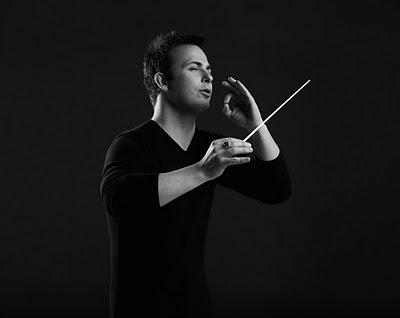Yannick Nézet-Séguin conducts the Philadelphia Orchestra.

Just Like (Starting Over): Yannick Nézet-Séguin
On Friday afternoon, Yannick Nézet-Séguin took a break from his duties conducting Faust at the Metropolitan Opera to lead the Philadelphia Orchestra at the Kimmell Center. The program featured two works that were premiered by that famous ensemble, along with Tchaikovsky's reliable Symphony No. 2.
The concert opened with Jennifer Higdon's Concerto for Orchestra, written in 2002 and premiered as part of the Orchestra's centennial celebrations. Dr. Higdon gave her work a brilliant opening. Synchronized taps on the orchestra bells and timpani created a new sound and a mysterious, meditative atmosphere that paved the way for an exciting first movement,
Perhaps the most memorable virtuoso moments in this work belong to the percussion, who dominate the fourth movement in the manner of a Javanese gamelan. Vibraphone, gong, timpani, bells and a complicated figure for temple blocks create an otherworldly sound not often heard in the staid surroundings of Verizon Hall.
Sergei Rachmaninoff's Rhapsody on a Theme by Paganini is a piano concerto in all but name. It is structured as a series of 24 variations on the last of Paganini's 24 Caprices for Solo Violin. The work was was premiered by the Philadelphia Orchestra with the composer himself at the piano at the Lyric Opera House in Baltimore. The year was 1934.
Here, the piano part was taken by Yuja Wang, the engaging 24-year old Chinese virtuoso and a familiar figure in Philadelphia, having studied piano at the Curtis Institute just down the street. Since then, Ms. Wang's flashy technique and smooth legato (not to mention a penchant for electric-blue evening gowns) has taken the piano world by storm. Ms. Wang brought drill-bit precision to the fast opening variations, expertly accompanied by Mr. Nézet-Séguin and an orchestra steeped in this work and its history.
The 18th variation is the most famous, a slow rendition of the original theme, played backwards. Rachmaninoff creates a dreamy, almost impressionistic aside, backed by the full power of the strings. Ms. Wang played this melody with warmth and elegance, swooping through the familiar passage with a graceful, yet powerful touch at the piano.
The Tchaikovsky Second opens quietly, with a very Russian-sounding theme for the solo bassoon backed by the horns. This theme was actually heard twice, as Mr. Nézet-Séguin stopped the first movement. He turned on the podium and looked daggers at the noisy audience, before continuing with the performance.
This was an engaging reading of the symphony known as the Little Russian with Mr. Nézet-Séguin urging his orchestra to new heights with each successive movement. The writing is very much in the style of Tchaikovsky's compatriots Mussorgsky and Rimsky-Korsakov, with folk-like melodies turning into exuberant, nationalistic celebrations by the horns and trumpets.
Following the symphony, Mr. Nézet-Séguin presented Verizon Hall with a beautifully wrapped Christmas present, an exuberant performance of the Russian Dance from Tchaikovsky's Nutcracker. The audience erupted in chuckles when they recognized the familiar ballet music. But this time, the conductor didn't stop and start over.

